#list of 1970s musical artists
Explore tagged Tumblr posts
Text
Tagged by the lovely @ride-a-dromedary for a list of my current five favourite songs (in no particular order)!
Sunset - Makoto Matsushita
昔みたい - Mebae Miyahara
Tired - The Wandering Hearts
Doomscroller - Metric
Paraclete Bhishajyati - Fire-Toolz
As with any individual song recommendations, I always say to listen to the albums they come from, in addition! (Aside from the Mebae Miyahara, as that is not on Spotify and only half on YouTube).
If anyone also wants to do this, say you were tagged by me! I can always list five more :).
#Thank you so so much for the tag! 🤍#These links are all to YouTube because Spotify is missing a ton of music from what I can tell#I wanted to put あの頃のあなた by Mebae but it is not online from what I could find#Maybe I should upload some full albums by more obscure artists to the internet for the masses#Anyway#I have many music recommendations#And I have been slowly working on importing and digitizing old Japanese records from the 1970s and 80s which is tons of fun#Because that music does not really exist anywhere online#And is very rare to find outside of Japan itself#I could have made a list of just those but I have to be more varied ;)#Not CATS
3 notes
·
View notes
Text
a list of cool website i found and use
radiooooo.com- pretty much you can listen to any music any place in the world and also... you can choose any TIME. Sometimes a person just likes to listen to russian music during the 1970s yk? (i recommend btw)
onelook.com (thesaurus)- can't seem to find the word you're thinking of? What the hell is that blanket that you only use for the couch/living area??? Oh wait- a throw. Go check out onelook, it has definitely saved me time for my writing.
datayze.com- CALLING ALL WRITERS, or i mean if youre gonna have a baby too ig this would work. datayze literally will help you find a name for your oc! And if you already have a name it gives you alot of good info you may want to know about your oc'c name. Or you could always make a name by mixing two together, like you can... on datatyze.
bandcamp.com- I cannot for the life me explain this website but TRY IT OUT, YALL. You can find alot of underground artists or new songs :D
mix.com- kind of like tumblr? but kind of like reddit? but also kind of like twitter? what im trying to say is that it's called mix for a reason. It takes cool things from multiple different websites and compiles it into one website, really cool when you're into a really specific fandom sometimes.
lab.nationalmedals.org- tbh idk, it's pretty and cool. it's pretty cool. i used to play this a lot.
worldchatclock.com- i use this for some of my friends that i volunteered with online to find a perfect time for us to meet. It finds a time where which you and up to a few people in different time zones can find a perfect meeting time.
earth.nullschool.net- so ive been getting back into flying my kite and this has been a life saver for my time.
radiogarden.com- i made a whole post about this website, uhh just look it up or try and find the post- im sorry im getting tired pLease
(I have like 2 other websites but i am not going to log into my old school email to try and find the bookmarked websites)
HONORABLE MENTION (actually i did this on purpose. best for last yk?)
azejournal.com- HELLO AROS AND ACES OR BOTH!! THIS IS THE WEBSITE FOR YOU. This is full of cool poems, stories, personal experiences, etc, about being aro or ace or both. I am literally in LOVE (no romo) with this website, it makes me feel more understood sometimes. Also I just love seeing us as a minority having a safe space to make and post creatively.
#aromantic#asexual#aroace#apec#aroallo#website#send help#im so tired#why did i make this#i stood up too long making this guys#i hope yall like it#radio#oc names#names#name searching#name suggestions#one look#radio garden#new music#music#time zone problems#time zones
860 notes
·
View notes
Text
youtube
"Something" is a song by British rock band the Beatles from their eleventh studio album, Abbey Road (1969). It was written by George Harrison, the band's lead guitarist, about his wife Pattie Boyd and is widely considered one of the greatest love songs of all time.
Apple Records issued the single as the flip side of "Come Together" (not as a "B" side, but as an "alternate A side") insisted by John Lennon, who considered "Something" to be the best song on the album. The single reached #1 in the US and three other countries (and was Top Ten in dozen more). The release marked the first time that a Harrison composition had been afforded A-side treatment on a Beatles single. In a 1990 letter to Mark Lewisohn, Alan Klein rebutted a claim made in the book The Complete Beatles Recording Sessions that the single was intended as a money-making exercise: Klein said it was purely a mark of Lennon's regard for "Something" and "to point out George as a writer, and give him courage to go in and do his own LP. Which he did."
Together with his second contribution to Abbey Road, "Here Comes the Sun", it is widely viewed by music historians as having marked Harrison's ascendancy as a composer to the level of the Beatles' principal songwriters, Lennon and Paul McCartney.
Harrison began writing "Something" in late 1968 during a session for the Beatles' White Album. In his autobiography, I, Me, Mine, he recalls working on the melody on a piano at the same time as McCartney recorded overdubs in a neighboring room at Abbey Road Studios. But Harrison suspended work on the song, believing that with the tune having come to him so easily, it must have been a melody from another song (something McCartney also wrestled with on "Yesterday"). Only after months of checking with other artists (and borrowing the opening lyric from fellow songwriter James Taylor, another Apple Records client), Harrison was able to work out the middle eight and finish it. Finally sometime in 1969, Boyd recalled: "He told me, in a matter-of-fact way, that he had written it for me. I thought it was beautiful. He first played it to me in the kitchen."
The promotional film for "Something" was shot in late October 1969, not long after Lennon privately announced that he was leaving the band. By this time, the band members had grown apart. As a result, the film consisted of separate clips, edited together, featuring the Beatles walking around the grounds of their homes with their respective wives. Harrison's segment shows him and Boyd together in their garden at Kinfauns. The four segments were edited and compiled into a single film clip by Neil Aspinall. Allan Kozinn noted: "What Mr. Aspinall's idyllic film avoided showing was that the Beatles were at that point barely on speaking terms. In the film, no two Beatles are seen together."
"Something" received the Ivor Novello Award for the Best Song of 1969. By the late 1970s, it had been covered by over 150 artists, making it the second-most covered Beatles composition after "Yesterday". Shirley Bassey had a top-five hit with her 1970 recording, and Frank Sinatra regularly performed the song, calling it "the greatest love song of the past 50 years." In 2000, Mojo ranked "Something" at number 14 in the magazine's list of "The 100 Greatest Songs of All Time".
A year after Harrison's death, his good friends McCartney and Eric Clapton performed a loving rendition of the song at the Concert for George tribute at London's Royal Albert Hall. Pattie Boyd said she was "moved to tears" by the performance.
#music video#1960s#rock and roll#legends#Ringo Starr#Linda McCartney#Maureen Starr#icons#vintage#60s rock
53 notes
·
View notes
Video
youtube
Larry Williams - She Said Yeah
‘Larry Williams (May 10, 1935 January 7, 1980) was an American rhythm and blues and rock and roll singer, songwriter and pianist from New Orleans, Louisiana. Williams is best known for writing and recording some rock and roll classics from 1957 to 1959 for Specialty Records, including "Bony Moronie", "Short Fat Fannie", "Bad Boy", "Dizzy Miss Lizzie" and "She Said Yeah," which were later covered by British Invasion groups and other artists. John Lennon, in particular, was a fan of Williams, recording several of his songs over the course of his career. "Bony Maronie" is listed as one of the Top 500 songs that shaped Rock and Roll.
Williams lived a life mixed with tremendous success and violence-fueled drug addiction. He was a long-time friend of Little Richard. As a child in New Orleans, Williams learned how to play piano. When he was a teenager, he and his family moved to Oakland, California, where he joined a local R&B group called the Lemon Drops. In 1954, when he was 19 years old, Williams went back to New Orleans for a visit. He began work as Lloyd Price's valet and developed a friendship with Little Richard Penniman, who was recording at the time in New Orleans. Price and Penniman were both recording for Specialty Records at the time. Williams was introduced to Specialty's house producer, Robert Blackwell, and was signed to record.
In 1957, Little Richard was Specialty's biggest star, but bolted from Rock and Roll to pursue the ministry. Williams was quickly groomed by Blackwell to try to replicate his success. Using the same raw, shouting vocals and piano-driven intensity, Williams scored with a number of hit singles. Williams' three biggest successes were "Short Fat Fannie", which was his first hit, reaching #5 in Billboard's pop chart, "High School Dance", which also made #5, and "Bony Moronie", which peaked at #14. Both "Short Fat Fanny" and "Bony Moronie" sold over one million copies, gaining gold discs. Several of his songs achieved later success as revivals by The Beatles ("Bad Boy", "Slow Down", and "Dizzy Miss Lizzy"); The Rolling Stones ("She Said Yeah"); and John Lennon's versions of "Bony Moronie" and "Dizzy Miss Lizzy".
Williams had been involved with underworld activity since his early teens, and had reputedly been a pimp before he ever recorded music. After 1957 Williams did not have much success selling records. He recorded a number of songs in 1958 and 1959, including "Heebie Jeebies", with band members such as Plas Johnson on tenor sax and Alvin "Red" Tyler on baritone, Barney Kessel on guitar, Gerald Wilson on trumpet, Ernie Freeman or Williams himself on piano, and Earl Palmer on drums. He was convicted of dealing narcotics in 1960 and served a jail term, setting back his career considerably.
Williams made a comeback in the mid-1960s with a funky soul band that included Johnny "Guitar" Watson, which paired him musically with Little Richard who had been lured back into secular music. He produced two Little Richard albums for Okeh Records in 1966 and 1967, which returned Little Richard to the Billboard album chart for the first time in ten years and spawned the hit single Poor Dog. He also acted as the music director for the Little Richard's live performances at the Okeh Club. Bookings for Little Richard during this period skyrocketed. Williams also recorded and released material of his own and with Watson, with some moderate chart success. This period may have garnered few hits but produced some of his best and most original work.
Williams also began acting in the 1960s, appearing on film in Just for the Hell of It (1968), The Klansman (1974), and Drum (1976).
In the 1970s, there was also a brief dalliance with disco, but Williams' wild lifestyle continued. By the middle of the decade, the drug abuse and violence was taking its toll. In 1977, Williams pulled a gun on and threatened to kill his long-time friend, Little Richard, over a drug debt. They were both living in Los Angeles and addicted to cocaine. Little Richard bought drugs from him, arranged to pay him later, but did not show up because he was high. Williams was furious. He hunted him down but ended up showing compassion on his long-time friend after Little Richard repaid the debt. This, along with other factors, led to Little Richard's return to born again Christianity and the ministry, but Williams would not escape LA's seedy underworld.'
SOURCE: Wikipedia
18 notes
·
View notes
Text
we have joked about MCR keith. we have cried about mitski keith. but i firmly believe the True Keith Music Characterization(TM) is that keith actually has no discernable music identity at all. keith lists his top 5 favorite artists and they're all so completely different in genre and vibe and decade and sometimes even language that you're just like ???????? was this kid synthesized in a swedish lab or something
in my HEART i know that keith has the most eclectic taste in music known to mankind. i think keith grew up in the middle of bumfuck nowhere where his only sources of music were 1) his dad's extensive collection of cassette tapes from the 1970s and 80s (note: keith's dad did NOT carefully curate his collection of cassette tapes, he actually just bought a random box of tapes at a yard sale and then tailored his personality around them accordingly) and 2) their ancient clunky boombox that permanently resided on the wobbly picnic bench behind their house. said boombox specifically picked up only 11 radio stations: 5 different Christian radio stations, 3 stations devoted entirely to Christian country music, 2 stations that played nothing but static, and occasionally, when the stars aligned, whatever music the radio station at the local community college three counties away would play.
#turning on the radio in maine is a living nightmare#voltron#keith#texas kogane#even though i don't even hc keith's last name as kogane. that is still my tag for his dad.#shitpost#katiecanons#keith: hey pass the aux cord#keith: (plays a band that is so obscure the only reference to its existence is a byline mention in a local music magazine from 1968)
173 notes
·
View notes
Text
Riding to Vanity Fair
I know this song has been on the McLennon songs list for a long time, but I recently listened to it again and was struck by how much it is about John. And what a different perspective Paul takes here. He usually sang how much he loved John, and here he reveals his frustration, possibly in reference to the conflict from the 1970s.
The first verse goes:
I bit my tongue I never talked too much I tried to be so strong I did my best I used the gentle touch I've done it for so long
which reminds me of this quote:
“I always find myself wanting to excuse John’s behaviour, just because I loved him. It’s like a child, sure he’s a naughty child, but don’t you call my child naughty".
Paul continues singing and decides to stop suppressing his anger and resentment towards the other person:
I'll tell you what I'm gonna do I'll try to take my mind off you And now that you don't need my help I'll use the time to think about myself
which reminds me of:
There’s no hard feelings or anything, but you just don’t hang around with your ex-wife. We’ve completely finished. ’Cos, you know, I’m just not that keen on John after all he’s done. I mean, you can be friendly with someone, and they can shit on you, and you’re just a fool if you keep friends with them. I’m not just going to lie down and let him shit on me again. I think he’s a bit daft, to tell you the truth. I talked to him about the Klein thing, and he’s so misinformed it’s ridiculous.
This excerpt touches me the most:
The definition of friendship Apparently you're to be Showing support for the one that you love And I was open to friendship But you didn't seem to have any to spare While you were riding to Vanity Fair
What the "riding to Vanity Fair" would be? My interpretation is that this is what John was doing during his interview with Jann Wenner in 1970 (later released as Lennon Remembers): belittling Paul's talent, criticizing him for taking the initiative in The Beatles, and presenting himself and Yoko as True, Non-Commercial Artists.
Some people believe that the song is addressed to a woman. I think this is nonsense. Even if we ignore everything I wrote earlier, look at this:
There was a time When every day was young The sun would always shine We sang along When all the songs were sung Believing every line
This "believing every line" could be a reference to John and Paul's communications through music.
I don't think Paul hated or hates John (or vice versa). However, I think he had the right to be angry with him and feel sorry.
#mclennon#mclennon tinted song analysis#chaos and creation in the backyard#paul mccartney#john lennon
84 notes
·
View notes
Text
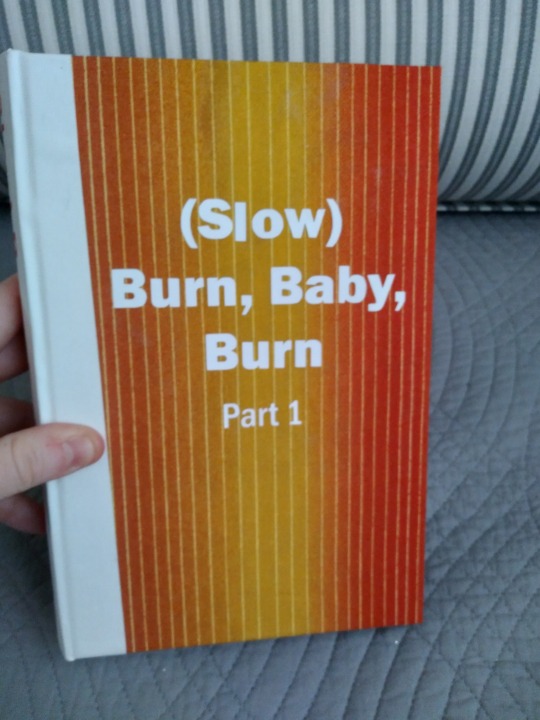
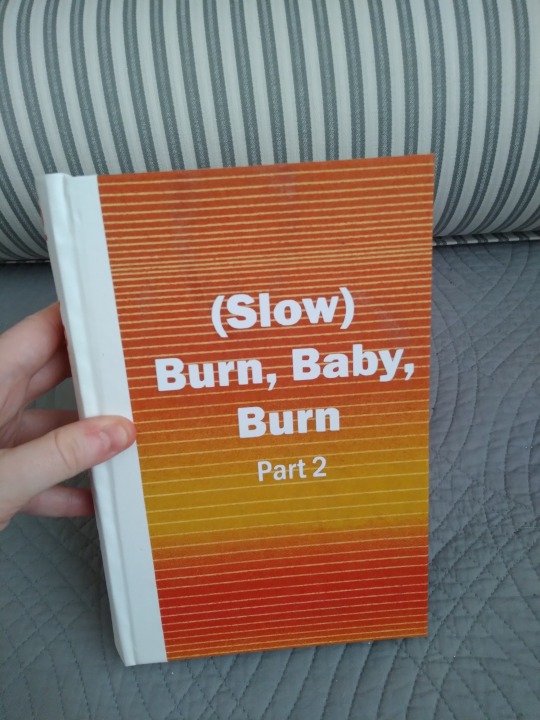
Very belated Binderary books, uh...I've lost track actually. I think they are #6 and #7. And it's another two-volume split! This is (Slow) Burn, Baby, Burn by orchidlocked, an extremely long Good Omens fic set in the 1970s. It's about our favorite angel/demon pair navigating the disco scene, and it's not an AU, which is sort of usual in a fic this long and with such a specific premise. There are a fair few real people featured here, some as major characters, and a lot of music history and an excellent playlist alongside all the fun and angsty relationship stuff that so many of us are here for. I learned a lot about disco reading this fic and it was fascinating and also way more queer than I ever realized.
For the cover up there we have a white Allure book cloth on the spine, and white HTV over homemade book cloth for the main cover. The cloth pieces both come from the same sheet but I oriented the stripes this way so they'd be coordinated-but-not-matched and I really love the effect. They're also cotton and really nice to hold. It's funny, I was thinking of binding this fic when I found the fabric while digging through the Joann's remnant bin, and as soon as I saw it this fic not only came to mind but moved up to the top of the to-bind list. It was fate, clearly.
More photos under the cut!

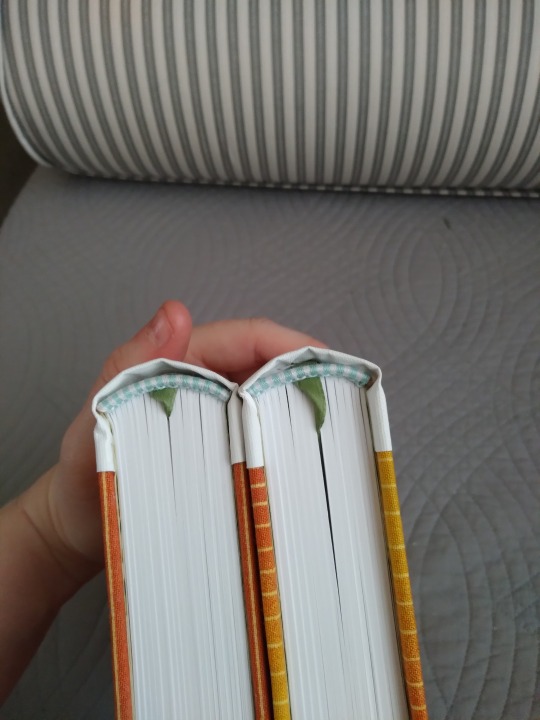
Both spines and a top view. That's orange HTV for the titles. This it the first time I've worked with matte HTV (I usually use metallic or foil) and I was surprised at how much thinner it is, and how easy it was to stick. And I like the color inverse here in counterpoint to the front cover. The top view shows off the handmade endbands and bookmark, and also the rounding job. I'm still working on rounded spines, and the turn-in over the spine didn't come out as smooth as I'd have liked, but I think it's a good result. The ribbon bookmark was supposed to be blue to match the endbands, but every blue ribbon I could find clashed horribly with the cover so it's this nice leafy sage green. Which actually works really well with...
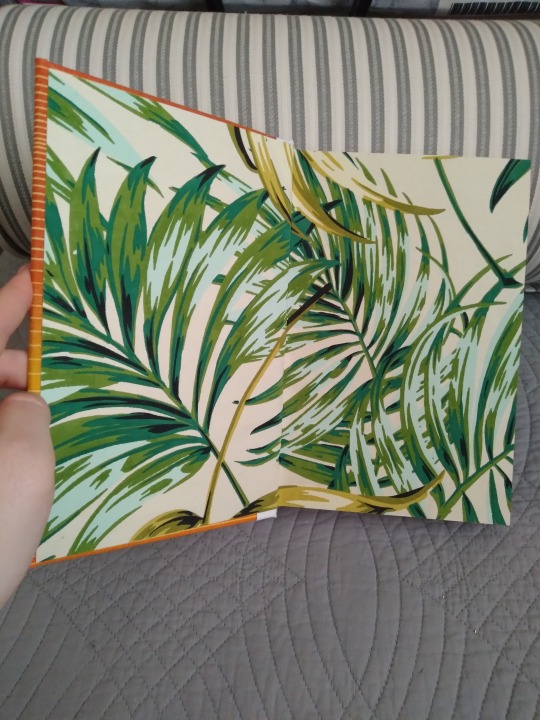
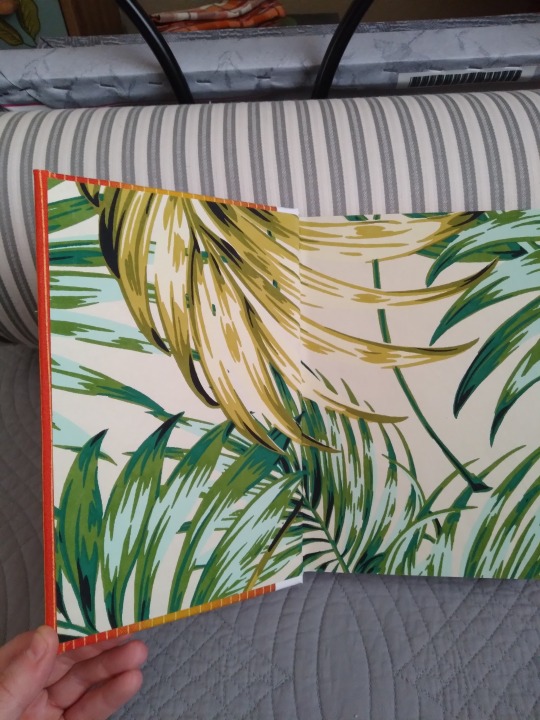
The endpapers! I got these as Joann's too. All four are cut from the same print, but I shifted and rotated them when I trimmed them so the patterns wouldn't all be in the same place. I had desperately wanted this other paper I found on Etsy with little vinyl records all over it, but the pieces weren't the right shape and I'd have had to ship them from overseas ($$), but I like the mood these ones set. And they're thick and nicely textured and look awesome with the cover, so really I think things worked out very well.
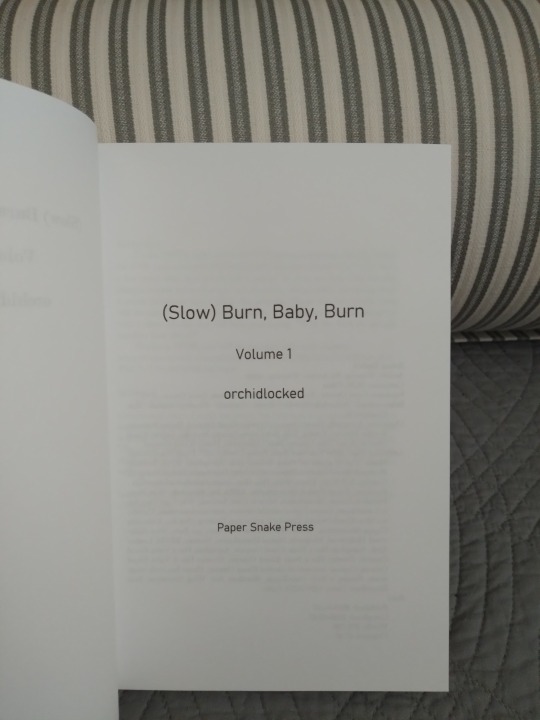
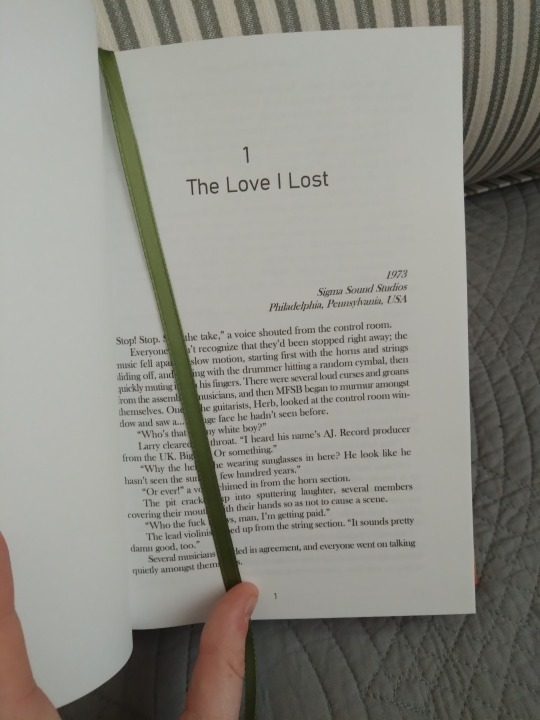
Couple of pics of the interior. I kept it fairly simple but I feel like it fits the story.
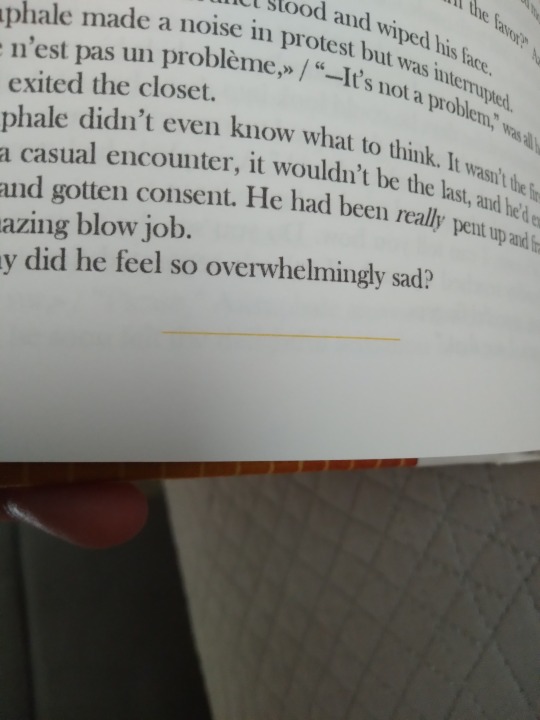
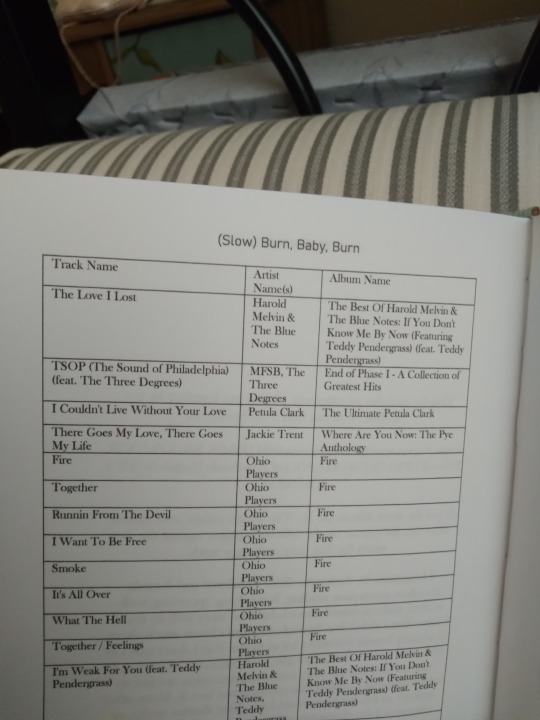
The scene break line is orange, to match the covers. I usually use gray but wanted something more fun. I recently bought some off-white paper that I used for most of my binderary projects this year because I've heard it's easier on the eyes, and it is, but I used the older bright white for this so the color contrast would be sharper. No complaints; I think it looks amazing. The second image above is the appendix I put together for the volume. Being so centered in the music industry, this fic has a really long playlist that the author put together with their preferred recordings. It's linked in the story and I did include the link text in the book, but I had my mind on preservation and the challenges of digital archiving while I was making this one, so I also took all the title/artist/album info and just listed it here. It was too much to do all by hand, so I learned how to export a Spotify playlist into an Excel doc, then moved that into the Word doc to print. A lot of steps, but not nearly as hard as I'd thought, and way less tedious.
I have to say this book is aesthetically really different than all my previous ones. I ran into so many design hurdles but I honestly couldn't be more pleased with the end result. I'll have to push my comfort zone like this more often, I guess.
#bookbinding#fanbinding#snek makes books#good omens#it's disco so it needed to be appropriately funky#and i think i nailed it actually#look at them they're awesome
39 notes
·
View notes
Text

Charles Edward Anderson Berry (October 18, 1926 – March 18, 2017) was an American singer, guitarist and songwriter who pioneered rock and roll. Nicknamed the "Father of Rock and Roll", he refined and developed rhythm and blues into the major elements that made rock and roll distinctive with songs such as "Maybellene" (1955), "Roll Over Beethoven" (1956), "Rock and Roll Music" (1957), and "Johnny B. Goode" (1958). Writing lyrics that focused on teen life and consumerism, and developing a music style that included guitar solos and showmanship, Berry was a major influence on subsequent rock music.
Born into a middle-class black family in St. Louis, Berry had an interest in music from an early age and gave his first public performance at Sumner High School. While still a high school student, he was convicted of armed robbery and was sent to a reformatory, where he was held from 1944 to 1947. After his release, Berry settled into married life and worked at an automobile assembly plant. By early 1953, influenced by the guitar riffs and showmanship techniques of the blues musician T-Bone Walker, Berry began performing with the Johnnie Johnson Trio. His break came when he traveled to Chicago in May 1955 and met Muddy Waters, who suggested he contact Leonard Chess, of Chess Records. With Chess, he recorded "Maybellene"—Berry's adaptation of the country song "Ida Red"—which sold over a million copies, reaching number one on Billboard magazine's rhythm and blues chart.
By the end of the 1950s, Berry was an established star, with several hit records and film appearances and a lucrative touring career. He had also established his own St. Louis nightclub, Berry's Club Bandstand. He was sentenced to three years in prison in January 1962 for offenses under the Mann Act—he had transported a 14-year-old girl across state lines for the purpose of having sexual intercourse. After his release in 1963, Berry had several more successful songs, including "No Particular Place to Go", "You Never Can Tell", and "Nadine". However, these did not achieve the same success or lasting impact of his 1950s songs, and by the 1970s he was more in demand as a nostalgia performer, playing his past material with local backup bands of variable quality. In 1972, he reached a new level of achievement when a rendition of "My Ding-a-Ling" became his only record to top the charts. His insistence on being paid in cash led in 1979 to a four-month jail sentence and community service, for tax evasion.
Berry was among the first musicians to be inducted into the Rock and Roll Hall of Fame on its opening in 1986; he was cited for having "laid the groundwork for not only a rock and roll sound but a rock and roll stance." Berry is included in several of Rolling Stone magazine's "greatest of all time" lists; he was ranked fifth on its 2004 and 2011 lists of the 100 Greatest Artists of All Time and 2nd greatest guitarist of all time in 2023. The Rock and Roll Hall of Fame's 500 Songs That Shaped Rock and Roll includes three of Berry's: "Johnny B. Goode", "Maybellene", and "Rock and Roll Music". "Johnny B. Goode" is the only rock-and-roll song included on the Voyager Golden Record.
On March 18, 2017, Berry was found unresponsive at his home near Wentzville, Missouri. Emergency workers called to the scene were unable to revive him, and he was pronounced dead by his personal physician. TMZ posted an audio recording on its website in which a 911 operator can be heard responding to a reported cardiac arrest at Berry's home.
Berry's funeral was held on April 9, 2017, at The Pageant, in Berry's home town of St. Louis. He was remembered with a public viewing by family, friends, and fans in The Pageant. He was viewed with his cherry-red Gibson ES-335 guitar bolted to the inside lid of the coffin and with flower arrangements that included one sent by the Rolling Stones in the shape of a guitar. Afterwards a private service was held in the club celebrating Berry's life and musical career, with the Berry family inviting 300 members of the public into the service. Gene Simmons of Kiss gave an impromptu, unadvertised eulogy at the service, while Little Richard was scheduled to lead the funeral procession but was unable to attend due to an illness. The night before, many St. Louis area bars held a mass toast at 10 pm in Berry's honor.
One of Berry's attorneys estimated that his estate was worth $50 million, including $17 million in music rights. Berry's music publishing accounted for $13 million of the estate's value. The Berry estate owned roughly half of his songwriting credits (mostly from his later career), while BMG Rights Management controlled the other half; most of Berry's recordings are currently owned by Universal Music Group. In September 2017, Dualtone, the label which released Berry's final album, Chuck, agreed to publish all his compositions in the United States.
Berry is interred in a mausoleum in Bellerive Gardens Cemetery in St. Louis.
Daily inspiration. Discover more photos at Just for Books…?
8 notes
·
View notes
Text
Listed: Amy Rigby

Photo by Bert Eke
The singer-songwriter Amy Rigby got her start in the late 1980s and early 1990s in spry, New York-based country throwback groups Last Roundup and The Shams. Starting with 1996’s Diary of a Mod Housewife, Rigby has steadily released solo work that can break your heart with the contagious ache in her dry, distinctive voice or make you laugh out loud at the concussive put-downs she doles out. Rigby has a particular knack for turning the quotidian mythic and reminding us that the mythologized are ultimately just some guys. The music has remained rooted in country, but not confined by it. Hers is a guitar-forward style that can incorporate the bright highs of acoustic pop rock, crunchy roadhouse grooves, R&B, and even jazz. Alex Johnson, in his review of Rigby’s most recent release, Hang In There With Me, called the album “tough, witty rock and roll…[that] catalogs a lifetime of drags, uncertainties and disasters, but returns, again and again, to the people, moments and experiences that make it worthwhile, or bearable enough.”
Here are some things that Rigby has been listening to lately.
Warmduscher — “Eight Minute Machines”
Discovered via an online review of their Brooklyn show last year, one that made me want so badly to be sweating in a crowd with this band onstage.
Amelia White — “Get To The Show”
youtube
One of my Nashville pals and I love this track from her latest album. Amelia is always out working and rocking, written with the great Gwil Owen… Sometimes I really do miss Nashville!
Daniel Romano — “Impossible Green”
You know when you discover an artist and think wow, this kid’ll go far, then realize they’ve been at it for years, made tons of records, play all the instruments, write, sing and tour their ass off? That’s how it is for me with Daniel Romano. This track comes from his 2017 album Modern Pressure.
Gina Birch — I Play My Bass Loud
youtube
Gina’s debut solo album came out just a year ago — I’ve been a fan since hearing the Raincoats in the late 1970s and getting to see them live when they came to NYC back then. She’s one of my heroines for being an artist and uniquely herself in whatever it is she does — music, video, painting. The bass and her opening line: “Sometimes I wake up, and I wonder — what is my job?” Pure Gina/genius!
Wreckless Eric — Inside The Majestic
He’s my husband and labelmate so what the hell — this is from his most recent album Leisureland. People know Eric for his voice and lyrics and guitar, but this is an instrumental track that’s just glorious. I want to see the movie it soundtracks, or at very least a choreographed dance routine with Eric at the piano in a tuxedo.
Michele Stodardt — “These Bones”
youtube
A big attraction for me with the Magic Numbers was Michele Stodart’s bass playing and cool vocal contributions, love hearing and seeing her do her solo thing.
Meshell Ndgeocello — The Omnichord Real Book
youtube
For the last dozen years, I was bartending/selling books at a small shop in New York’s Hudson Valley. The first time Meshell came in I was tongue-tied, knowing her as a bass playing legend and poet, and thought if she lives here, it’s kind of the center of the universe, right? I really hope to see her play live sometime.
TBHQ — “Planet of Pain” from TBHQ
A radio host on a show I guested on was playing this great track when I walked in. “I really like that,” I thought, and then realized it was my daughter Hazel Rigby who records under the name TBHQ. She’s been performing and recording for years, often instrumental/noise but her voice and lyrics are so wise and honest.
Dory Previn — “The Comedian”
youtube
There’s never been anyone like Dory Previn, the pain and ridiculousness of being a human so acutely depicted in song. There’s a new documentary about her, On My Way To Where, by my friend Julia Greenberg with animated segments by Emily Hubley, just making its debut out there. She had a fascinating, fruitful, difficult beautifully productive life and I can’t wait to learn more about her.
Mary Timony — “Dominoes” from Untame The Tiger
Love everything about Mary Timony’s latest solo album Untame the Tiger — the songs, the guitar playing, her voice, the cover!
Swamp Dogg — “Synthetic World”
youtube
One of my favorite tracks of all time. Jerry Williams (Swamp Dogg) is still out bringing his music to the people. I’m looking forward to seeing the new documentary Swamp Dogg Gets His Pool Painted — there’s just nobody like this guy.
#dusted magazine#listed#amy rigby#warmduscher#amelia white#daniel romano#gina birch#wreckless eric#michele stodardt#meshell ndgeocello#TBHQ#dory previn#mary timony#swamp dogg
8 notes
·
View notes
Text

Remembering singer and songwriter, Barry White who died 21 years ago today. A two-time Grammy Award winner known for his bass voice and romantic image, his greatest success came in the 1970s as a solo singer and with the Love Unlimited Orchestra, crafting many enduring soul, funk, and disco songs such as his two biggest hits: "Can't Get Enough of Your Love, Babe" and "You're the First, the Last, My Everything".
He had 20 gold and 10 platinum singles, with worldwide record sales in excess of 100 million records, and is one of the best-selling music artists of all time.
In 2023, Rolling Stone ranked him at number 56 on its list of the 200 Greatest Singers of All Time.
May he continue to Rest In Paradise. 🕊️🙏🏾🎶🖤🤎
10 notes
·
View notes
Text
Soul Around The World in 25 tracks
Soul music became popular around the world, influencing countless artists across the world. We’ve put together a list with 25 awesome soul tracks form Africa, Asia, Europa and Latin America.

African Hustle - Geraldo Pino (Boogie Fever, 1978) - Sierra Leone
Ahl Jedba - Fadoul (Al Jedba / Al Hayra, 197?) - Maroc
Durban Bump Jive - Thomas Motshwane (Pretoria Bump Jive / Durban Bump Jive, 1975) - South Africa
Funky But… - Mads Vinding Group (Danish Drive, 1974) - Denmark
Gandjal Kessoum - Hamad Kalkaba And The Golden Sounds (Gandjal Kessoum / Toufle, 1975) - Cameroon
Hot Pot - Francois de Louville (La Complainte Du Partisan / Hot Pot, 1969) - France
Jazz Goes to Beat I - Václav Zahradník Big Band (Jazz Goes to Beat, 1970) - The Czech Republic
Jangolo (Les Mangues) - Jo Tongo ( Jangolo, 1976) - Cameroon
Lagos Sisi - Bola Johnson & His Easy Life Top Beats (Lagos Sisi / Jeka Dubu, 1973) - Nigeria
Major Minor - Crazy Casey (The Beast And I, 1967) - The Netherlands
Malombo Blues - Malombo (Pele Pele, 1976) - South Africa
Matshatsha - Trio Madjesi & Orchestre Sosoliso (Matshatsha / Good Bye Yuna, 1973) - Zaïre
Mbaye Sasu - Le Xalam (Daïda, 1975) - Senegal
Nadim - Freh Khodja (Bachar Fi Leil, 1978) - Algeria
Na Man Pass Man (Na Iron De Cut Iron) - Pasteur Lappe (a Man Pass Man, 1979) - Cameroon
Nana - The Lulus Band (Nana / Ndiregete Twendane, 1976) - Kenya
N'Zambi - Lilly Tchiumba (N'Zambi É Deus, 1973) - Angola
Passage To Prerov - Jack van Poll Tree-Oh (Hi Jackin', 1972) - The Netherlands
Ray Mbelle - Orchestre Baobab Gouye Guy De Dakar (Ken Dou Werente, 1983) - Senegal
Roll On The Left Side - Knut Kiesewetter Train (Stop! Watch! And Listen!, 1970) - Germany
Sesion Verde - Toño Quirazco (Soul Makossa, 1973) - Mexico
Streap-Tease In The Stars - Sirarcusa (Give Me Your Love / Streap-Tease In The Stars, 1977) - Spain
Wait… No Hurry - Grotto-II (Wait… No Hurry, 1978) - Nigeria
Waqtach Tef'hem - Les Frères Mégri (Younes Et Mahmoud, 1977) - Marocco
Way Back Fifties - The Drive (Can You Feel It, 1975) - South Africa
More Soul Around the World
Soul Around the World in 24 tracks
Soul Around The World
Soul Around The World in 34 songs
Soul Around The World in 27 Songs
Soul Around the World in 20 tracks
Soul Around The World in 22 tracks
Soul Around The World in 33 songs
Soul Around The World in 20 tracks
6 notes
·
View notes
Note
movie anon from yesterday coming in to say that i definitely want to know what your favourite movies are, doesn't matter if they are black and white. maybe looking at the list will inspire some confidence to recommend the movies i like too
It’s a bit scary, isn’t it, to share the films that mean something to you on the internet, instead of your two or three close friends you can have longer conversations with and know where you are coming from. For example, there is a very short film directed by Pier Paolo Pasolini called Che cosa sono le nuvole (What are clouds, 1967) which is one episode included in a broader project with other directors and a plethora of very well known artists and actors from that time period that you would have gone and seen as part of a film anthology. It’s just so brilliant, I have to see it again every once in a while. But how would other people take Ninetto Davoli’s blackface? Many times done callously or uncritically in the past, it’s a very good thing to criticize and being disappointed with. In this case, I would say that it is definitely not a mockery on Pasolini’s part, considering the characters are talking marionettes recreating the story of The Tragedy of Othello and the face of Jago-Totò is also painted, in green. And the relationship between Europe and Africa in the context of the process of decolonization that was taking place was too much part of the context and of utter relevance at the time, even for other segments of the anthology. One should also see his documentary film Appunti per un'Orestiade africana, for better measure Pasolini’s choices and his level of awareness in terms of representation. Che cosa sono le nuvole is all about representation after all, the complex relationships between characters, story, the author and the public. The marionettes develop a consciousness about the story they are telling as they are telling it without seemingly knowing what it means and why they are doing what they are doing, asking the puppeteer, who gives them rather unsatisfactory answers. Meanwhile the audience gets so angry at Othello and Jago that they intervene to save Desdemona in the end. The two “bad marionettes” get put in the trash and taken away to a landfill where they are able to see the sky for the first time. I think that I love it so much because in 20 minutes there is so much punch, emotion and eloquence, the music is perfect, the words outstanding, the tragic-comedic tone never overdone and the irony and deep sadness and mystery and beauty of life are so very well communicated. I don’t know if I have ever seen a perfect synthesis in film like this one or someone able to trust so much his audience while also knowing that misunderstanding and bad judgment and condemnation will also be inevitable parts of making art.
I like old films, the texture and the use of light and frame, more than cutting edge pacing and special effects. Color palette, music choices and audio effects and the presence of actors that I am able to withstand and tolerate if there are closeups of their faces also are details that usually make me love a movie or dislike it. And I especially like noir, mystery and cosmic horror vibes, although I am also very much into neorealism and melodrama. So here a brief list of my favorites: Wuthering Heights (1939), Kiss me deadly (1955), Luchino Visconti’s Ossessione (1943) and Rocco e i suoi fratelli (1970), The birds (1963), 8 1/2 (1963), Kwaidan (1964), Wild at heart (1990).
It’s a weird bunch and there are many other titles that are coming up in succession, but I am going with the ones that are imprinted more clearly in my mind: considering my very bad memory it means that they had a strong impact. Please if you want to share yours, let me know as well, even if they are titles that aren’t necessarily in the top ten of many cinephiles. I don’t consider myself one, I missed for lack of commitment or purposely ignored too many of the ones considered important. Thank you for these asks!
9 notes
·
View notes
Text
ELVIS RECORDED A SONG FOR HIS FATHER
The story of the track “If I’m A Fool (For Loving You)” recorded at the American Sound Studio in Memphis, Tennessee (1969)

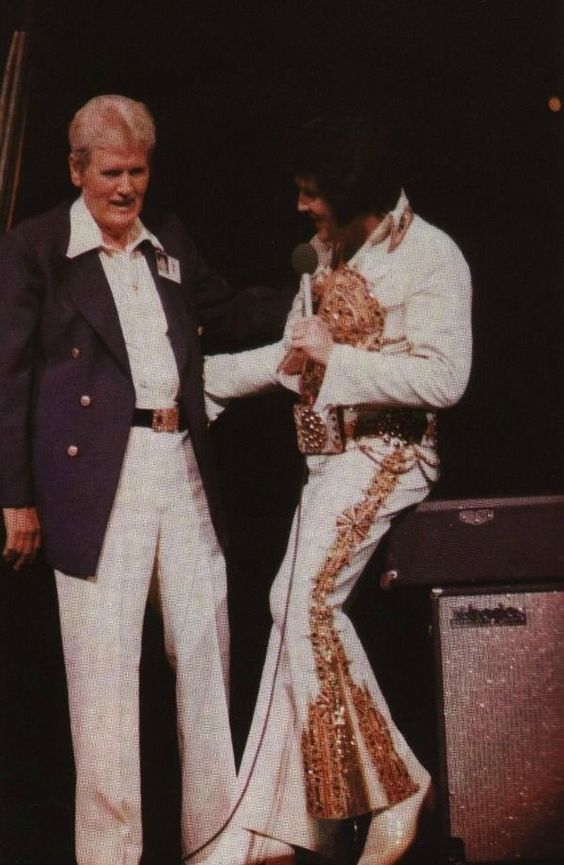
[ABOVE] Elvis and his father, Vernon Presley, early 60s and 70s.
- - - - - - - - - - - - - - - - - - - - - - - - - - - - - - - - - - - - - - - - - - - - - - - -
JANUARY 20, 1969 - AMERICAN SOUND STUDIO, MEMPHIS TENNESSEE
Elvis was working with the musicians in the studio since the night before, January 19. The night went on and it was already past midnight when, during a pause to catch the breath, Elvis Presley casually finds another song to record yet at that same recording session.
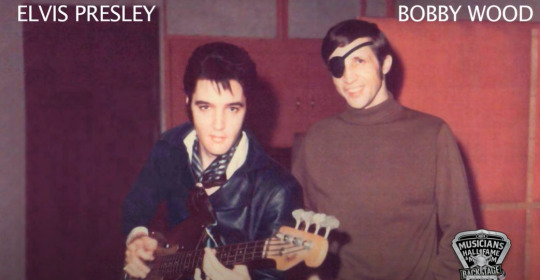
JANUARY 20, 1969 - AMERICAN SOUND STUDIO, MEMPHIS, TENNESSEE By 4:30 the next morning they were tired — and they’d pretty much exhausted the song list they’d come in with. Elvis and piano player Bobby Wood were sitting quietly on the piano bench talking about religion and music. Bobby had had a minor hit as a recording artist with “Searchin’” and had recorded Sun writer Stan Kesler’s “If I’m A Fool (For Loving You).” Elvis introduced Bobby to his father, and when Vernon said that “If I’m A Fool” was one of his favorites, Elvis decided to give it a try. Excerpt from "Elvis Presley: A Life in Music - The Complete Recording Sessions" (1998) by Ernst Jorgensen and Peter Guralnick
In an interview, this is what Bobby himself said about that moment:
Q: In 1964, you had a hit. Can you tell us when Elvis covered it? A: Yes, 'If I'm a Fool' in 1964 was a pretty big hit for me and so Elvis had know about that and his dad came in one night at the studio while we were recording Elvis. And he said, 'Dad, I'd like to have you meet somebody here'. And so he brought him over and I shook hands with him and then he introduced us and he said, 'Do you know who this guy is?' And he said, 'No, I'm not sure'. So Elvis said, 'What's your favorite record'. And he said, 'If I'm a Fool'. And he said, 'This is the guy that sang it'. And of course his father just said, 'Woah'. So Elvis went on and did it for his dad because that was one of his dad's favorite songs at the time.
Source: www.elvis.com.au
— BOBBY WOOD'S "IF I'M A FOOL (FOR LOVING YOU)", THE SONG VERNON PRESLEY HEARD AND APPRECIATED:
youtube
— [BELOW] Bobby Wood's EP released in 1964
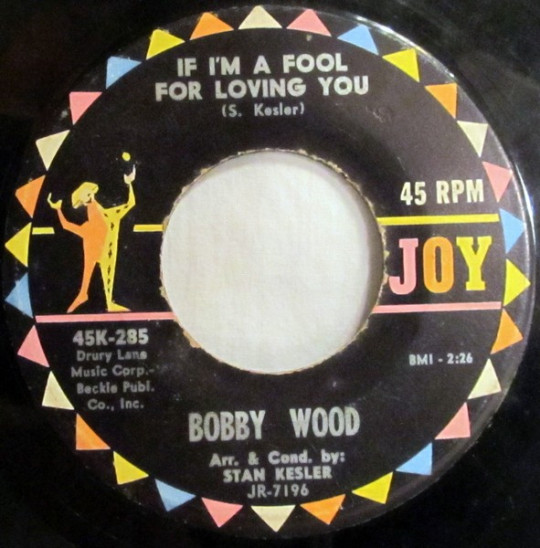
— [BELOW] ELVIS' RECORDINGS: TAKES 1, 2 & 3 — JANUARY 20, 1969
youtube
What Elvis thought about his own performance on the song:
Maybe it was just too late in the day to introduce a new song, but even with Bobby’s help the master they produced elicited only one word from Elvis: “Rotten.” It’s a measure of how high Elvis’s standards had risen by this point: The master of “If I’m A Fool” may have been one of the lesser cuts Elvis made at American, but measured against the years of Hollywood soundtrack crap that came before, it was still a giant leap of musicality. Excerpt from "Elvis Presley: A Life in Music - The Complete Recording Sessions" (1998) by Ernst Jorgensen and Peter Guralnick
- - - - - - - - - - - - - - - - - - - - - - - - - - - - - - - - - - - - - - - - - - - - - - - -
THE MASTER OF "IF I'M A FOOL (FOR LOVING YOU)" WAS FIRST RELEASED IN 1970 IN THE COMPILATION ALBUM "LET'S BE FRIENDS".

Later the track was also released in the reissued album "From Elvis in Memphis" as bonus track in the "40th Anniversary Edition" (legacy edition, 2009).
youtube
MUSIC INFO: IF I'M A FOOL (FOR LOVING YOU)
Lyrics by Stanley Kesler.
Recorded February 20, 1969 at American Sound Studio, Memphis.
Guitar: Reggie Young, Elvis Presley. Bass: Tommy Cogbill. Drums: Gene Chrisman. Piano: Bobby Wood, Elvis Presley, Ronnie. Organ: Bobby Emmons. Harmonica: Ed Kollis. Trumpet: R. F. Taylor, Wayne Jackson, Dick Steff. Sax & Trombone: Jackie Thomas. Sax: Glen Spreen, J. P. Luper. Trombone: Jackie Thomas, Jack Hale, Gerald Richardson, French Horn: Tony Cason, Joe D'Gerolamo. Vocals: Mary (Jeannie) Green, Donna Thatcher, Susan Pilkington, Mary Holladay, Dolores Edgin, Hurshel Wiginton, Joe Babcock, Millie Kirkham, Sonja Montgomery.
Source: www.elvisthemusic.com
- - - - - - - - - - - - - - - - - - - - - - - - - - - - - - - - - - - - - - - - - - - - - - - -
— ADDITIONAL INFO
Elvis didn't only covered one version from his pianist Bobby Wood previously recorded tracks, but two. Still from the "Elvis Presley: A Life In Music" book:
On the 22nd Elvis returned to do repairs and to try another song Bobby Wood had recorded, the religious “Who Am I”.
youtube
Elvis' second song cover that had been previously recorded by Bobby Wood, "Who Am I?" was recorded in February 22, 1969 at the American Sound Studio, and first released in March 1971 in the compilation album "You'll Never Walk Alone". The track followed the same destiny as "If I'm A Fool (For Loving You)" being later released as a part of the "From Elvis in Memphis – 40th Anniversary Edition" (2009) also as a bonus track. Unfortunately I couldn't find Bobby's recording, not even the released EP with it.
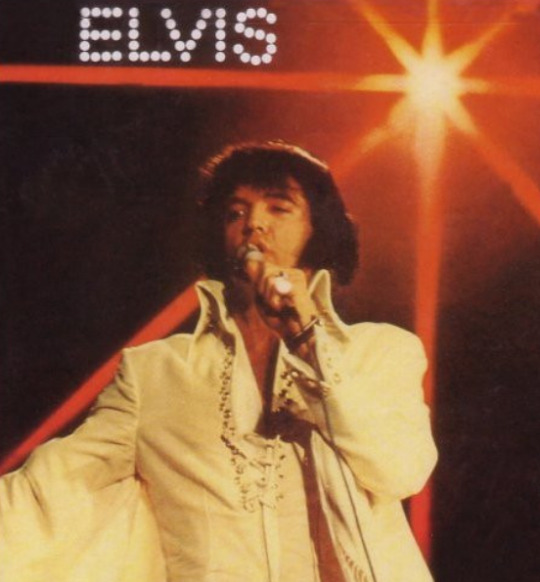

- - - - - - - - - - - - - - - - - - - - - - - - - - - - - - - - - - - - - - - - - - - - - - - -
Here's a quick interview in video with Bobby Wood telling how he met Elvis and his impressions of him.
You can read a longer interview HERE [elvis.com.au].
youtube
- - - - - - - - - - - - - - - - - - - - - - - - - - - - - - - - - - - - - - - - - - - - - - - -
Well, well, well. Such a nice info I came across today. I wonder if Vernon liked his son's version of Bobby Wood's country song "If I'm A Fool", one of his favorites at the time. Anyhow, it's cute to learn Elvis was not at first interested in recording this song until he acknowledged his father's personal liking of it. I guess it makes this tune a special gift to Vernon from his son, if you think about it. It was one 'at the spur of the moment' decisions when Elvis just followed his heart. ♥
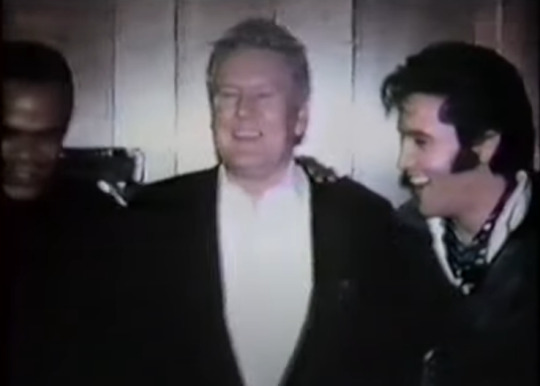

PICTURES: Elvis and his father, Vernon, and the R&B legend, Roy Hamilton, filmed during one of the recording sessions at the American Sound Studio in Memphis, Tennessee. Circa January 22, 1969.
#elvis presley#elvis music#elvis#american sound studio#memphis#memphis tennessee#musicians#recording session#1969#60s music#70s music#the presleys#elvis the king#elvis fans#elvis fandom#60s elvis#70s elvis#elvis history#Youtube
16 notes
·
View notes
Text
Great Guitarists 100 - The Edge, Thurston Moore, Prince, Brian Setzer, Peter Buck, and Johnny Marr [CROSSBEAT (November 2009)]


The Edge Today, U2 have a strong image as a 'popular band' and are not so much a player's band, but when they first appeared on the scene in the 80s, their political lyrics and The Edge's unique post-punk guitar, which combines Irish melancholy and sharp-edged distortion, attracted a great deal of attention. It brought excitement, especially among rock fans who were concerned about the rise of show-stopping metal guitars and synthesisers, which were often seen as inorganic, and who thought, "Here's the rock guitar that should be here!" Later, the Edge's post-punk guitars acquired an earthy, dry sound with their pilgrimage to America in 'Joshua Tree', and evolved to express the warm human touch behind the modern technology. From the 1990s onwards, U2 themselves were no longer in the position of 'youth culture bearers', and their musical influence was difficult to see because the band had become so big, but in the 2000s they were joined by a new generation of artists such as Coldplay, The Killers, and Kings of Leon, who proved once again their influence by developing a direct lineage to The Edge. Many people, including Nick Zinner of the Yeah Yeah Yeahs, have listed Edge as one of their guitar heroes. -Taiyo Sawada
Representative albums "Boy" (1980, photo) U2 "War" (1983) "Joshua Tree" (1987)
Thurston Moore Since their formation, Sonic Youth have reigned as the kings of the US alternative scene. The heart of their sound is, needless to say, their noisy, chaotic guitar sound. Thurston Moore, who was active in a garage band at the end of the 70s, has musical roots in the New York punk and garage sounds, as evidenced by the episode where he got the band name from former MC5 guitarist Fred "Sonic" Smith. The band's guitar style, which includes the Fender Jazz Master given to them by Patti Smith, as well as Jaguars and Mustangs, is lyrical, but always with a freaky, experimental spirit. One of the most distinctive features is a special tuning called irregular tuning. This enabled him to create overtones and dissonances that could not be obtained with a normal guitar. Of course, the interplay with Lee Ranaldo and Kim Gordon = guitar orchestration is one of the band's greatest attractions. Their dry yet deep guitar sound had a profound influence on future guitarists such as Kurt Cobain, Kevin Shields and Graham Coxon. -Takanori Kuroda
Representative albums "Daydream Nation" (1988, pictured), Sonic Youth "A Thousand Leaves" (1998) "The Eternal" (2009)
Prince He is a mixed-race black and white guitarist. Prince is often compared to Jimi Hendrix for this reason alone, but as a guitarist he has stated that Santana was rather a major influence on him. His long-sustained, sensational lead guitar is certainly reminiscent of Santana in the 1970s. Even in his early recordings, he developed a self-absorbed improvisation style that sounded like a mix of Santana and fusion. The closest he came to 60s rock, including Jimi Hendrix, were 'Purple Rain' and 'Around the World in a Day'. The latter's "America" sounds like Jimi backed by the JBs. Although not often mentioned, Prince is also a virtuoso acoustic guitarist. The unique chord work heard on tracks such as "For The Tears In Your Eyes" is strongly influenced by his admirer Joni Mitchell. -Masatoshi Arano
Representative albums "Purple Rain" (1984 photo), Prince & The Revolution "Around the World in a Day" (1985)
Brian Setzer Made his UK debut with rockabilly trio Stray Cats at the height of the New Wave era. Their sound, produced by Dave Edmonds and infused with punk nuances, was enthusiastically received and triggered the neo-rockabilly movement. Setzer's Gretsch-based playing is rich in vocabulary, with an eye on punks such as the Clash, but with no hidden jazz or country influences. He also shows flashes of genius on fast lead phrases. His versatility was fully realised later in the Brian Setzer Orchestra. After the band broke up, his solo debut, "The Knife Feels Like Justice", was produced by Don Gehman, who had worked with John Mellencamp and R.E.M., and went down the American rock route. A good album with a taste that pioneered alterna-country, but sadly neglected due to poor sales. -Masatoshi Arano
Representative albums "Stray Cats" (1981, photo) Stray Cats "The Knife Feels Like Justice" (1986) Brian Setzer
Peter Buck In the early days, R.E.M. was buried in a vocal ensemble, with Peter naturally taking the lead role in the songs. On the first mini-album 'Chronic Town', his sharp, post-bunk appearance played a big part. The traditional Rickenbacker sound, which relied neither on gain nor vibrato, was skilfully combined with a modern rhythmic feel, and greatly inspired the 60s revivalists of the same era. However, it was not until around 'Lifes Rich Pageant' that this style came to the fore. From 'Document' onwards, when Michael Stipe awakened as frontman, the band played freely in line with his evolution. "What's the Frequency, Kenneth?" and other hard-hitting tunes, he shows off his driving backing. His acoustic guitar precision can be heard on the masterpiece 'Automatic for the People'. -Masatoshi Arano
Representative albums Chronic Town (1982, photo) R.E.M. Automatic for the People (1992)
Johnny Marr Marr is a guitarist, composer and arranger in The Smiths. The main focus of his playing was to bring out the best in the songs. He filled in the gaps between notes with fluid single-note playing, and even went so far as to drop a knife into the guitar for sound effects on "This Charming Man". "Bigmouth Strikes Again", with its high-position cutting using a capo (transposing instrument), is a powerful tune. The delay on "How Soon Is Now?" is a real blast. The frequent use of higher tunings showed that the band were still seeking a sense of tension in their songs. However, the guitar remained in the background, with the singer and the song always taking centre stage. This behind-the-scenes quality blossomed after the break-up of The Smiths, giving The The, Modest Mouse, and The Cribs their greatest hits respectively. After The Healers, in which he played a leading role, ended in mediocrity, he wisely returned to the background. -Masatoshi Arano
Representative albums "The Queen Is Dead" (1986, pictured), The Smiths "We Were Dead Before the Ship Even Sank" (2007) Modest Mouse
#The Edge#U2#Thurston Moore#Sonic Youth#Prince#Brian Setzer#Stray Cats#Peter Buck#R.E.M.#Johnny Marr#The Smiths#Modest Mouse#my scan#translation#CROSSBEAT#CROSSBEAT November 2009
10 notes
·
View notes
Text
Year-End Poll #67: 2016

[Image description: a collage of photos of the 10 musicians and musical groups featured in this poll. In order from left to right, top to bottom: Justin Bieber, Drake, Rihanna, Twenty One Pilots, Desiigner, Adele, The Chainsmokers, Justin Timberlake, The Chainsmokers. End description]
More information about this blog here
We're now in 2016. A year that was at one point considered to be the worst in recent memory, a title that would only be surpassed by every year that came afterwards. But in terms of music, 2016 brought us a lot of heavy hitters. Anderson .Paak's Malibu, Rihanna's Anti, Frank Ocean's Blonde, Drake's Views, Beyoncé's Lemonade, and David Bowie's final album, Blackstar -- I would be here all day if I tried to list every release that came out this year.
But what's notable about this year of releases isn't just the albums themselves, but the music business landscape they were being released into. After the fall of physical media, the rise of music piracy in the MP3 era, and the popularity of digital storefronts, streaming services like Spotify seemed to be this great equalizer. This is an easier opinion to have if you forget that Spotify is a massive corporation, and if you're not an artist living off royalties. The controversy over streaming is nothing new. But this is when we start to see the landscape of streaming splintering.
Drake's Views and Beyoncé's Lemonade were not released to the wider streaming market, with exclusive releases on Apple Music and Tidal respectively. Much like the current debate over streaming services for movies and TV, listeners were suddenly finding themselves stretched thin between different streaming providers. Spotify, Apple Music, Tidal, Amazon Music, Pandora, YouTube, SoundCloud, and many others. This wasn't a new phenomenon (both SoundCloud and Pandora predate Spotify by almost a decade), but now we're seeing more platform-exclusive releases. Listeners responded in a variety of ways. Some people switched platforms or kept multiple subscriptions to different services. Some bought physical copies of exclusive releases and imported them into their preferred platform. Some just didn't listen to the releases. And others went right back to piracy, repeating the same problem the record industry had been trying to snuff out for several decades now. Platform-exclusive releases aren't that common anymore.
As far as the music itself goes, as the sound of electropop wanes in mainstream popularity, dance music is starting to incorporate influences from a variety of Caribbean styles of music, specifically dancehall as seen with Rihanna's Work and Drake's One Dance, and tropical house, as seen with Justin Bieber's Sorry and Sia's Cheap Thrills (not featured on poll). However, I do want to differentiate the two, because dancehall originated in Jamaica in the 1970's while tropical house is a relatively recent genre that incorporates stylistic elements of dancehall and other subgenres of house music.
When it comes to mainstream rap and hip-hop, trap music is continuing to dominate. With music platforms allowing artists easier access to distribution, a sub-sub genre sometimes known as SoundCloud rap started to find mainstream footing. Some people also call this style "mumble rap". I will not, because I find the term needlessly dismissive and kind of obnoxious. All of these rising genres put together helped to contribute to a musical landscape that was moody and generally at a slower tempo than the pop music of previous decades. It's often reductive to attribute popculture at the time to the current zeitgeist, but considering how today's poll features songs with titles like "Work" and "Stressed Out", it's too tempting not to.
#billboard poll#billboard music#tumblr poll#2010s#2010s music#2016#justin bieber#drake#wizkid#kyla#rihanna#twenty one pilots#desiigner#adele#the chainsmokers#daya#justin timberlake#halsey
58 notes
·
View notes
Text
THE NEW WAVE GUIDE
hello! this is an encyclopedic guide to the new wave subculture (written by yours truly). i hope this will help those who are attempting to get into the new wave movement :v) this is completely written by me without any research, so i might be incorrect on some things.
WHAT IS NEW WAVE?
new wave is a subculture/movement that sprouted from the post-punk era of the late 1970s and early 1980s. the movement draws from the aesthetics and musical influences of disco, punk, goth, and pop. the term refers to how this era was a “new wave” of a generation.
you can compare more modern aesthetics to new wave too! frutiger aero is a more internet focused aesthetic, but it’s reminiscent of new wave. you can see this in modern artists as well, such as Chappell Roan, who takes inspiration from 1980s pop and aesthetics
MUSIC
there are many artists and bands who are considered new wave. below is a list of some of the most essential artists
talking heads, jerry harrison, tom tom club, other solo projects
they might be giants/tmbg (first 2 studio albums)
oingo boingo
squeeze
devo, mark mothersbaugh
sparks
duran duran
klaus nomi
lene lovich, nina hagen
the residents (specifically their 1980 album, Commercial Album)
xtc, andy partridge
r.e.m (earlier albums like Reckoning and Murmur)
blondie
b-52s
the cars, the human league, a-ha
new order, soft cell
elvis costello
gary numan/tubeway army
there are many more artists, so feel free to explore them and listen to a few songs!
7 notes
·
View notes